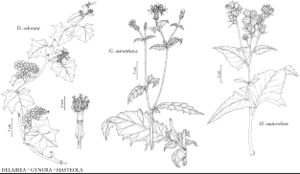Hasteola
New Fl. 4: 79. 1838.
| Taxon | Illustrator ⠉ | |
|---|---|---|
 | Delairea odorata Gynura aurantiaca Hasteola suaveolens | Yevonn Wilson-Ramsey Yevonn Wilson-Ramsey Yevonn Wilson-Ramsey |
Perennials, (50–) 60–240 cm. Stems usually 1, erect (unbranched proximal to heads). Leaves basal and cauline; alternate; petiolate (proximal) or sessile; blades pinnately nerved, broadly deltate or hastate (proximal) to broadly lanceolate, margins doubly-serrate, faces glabrous. Heads discoid, in corymbiform (± flat-topped) arrays. Calyculi of 4–9+ (subulate, rarely leaflike) bractlets. Involucres cylindric or campanulate to obconic, 5–8+ mm diam. (glabrous). Phyllaries persistent, 7–14+ in 1–2 series, erect, distinct, oblong, ± equal, margins chartaceous to scarious. Receptacles slightly convex or flat, foveolate, epaleate. Ray-florets 0. Disc-florets 10–55, bisexual, fertile; corollas usually white or ochroleucous to greenish, rarely pinkish, tubes longer than cylindric throats, lobes 5, erect to spreading, lanceolate; style-branches stigmatic in 2 lines, apices truncate or truncate-penicillate (appendages essentially 0). Cypselae cylindric-fusiform, 8–12-ribbed, glabrous; pappi persistent (fragile), of 100–150+, white, barbellulate bristles. x = 10.
Distribution
e United States
Discussion
Species 2 (2 in the flora).
Asian species that have been assigned to Hasteola belong to Parasenecio.
Selected References
Lower Taxa
Key
| 1 | Florets 10–14; proximal cauline leaves deltate | Hasteola robertiorum |
| 1 | Florets 18–55; proximal cauline leaves hastate to deltate or lanceolate | Hasteola suaveolens |